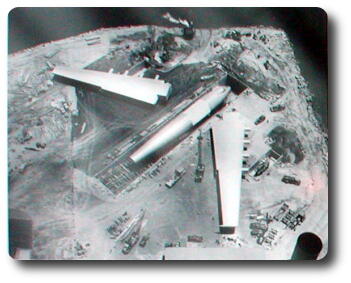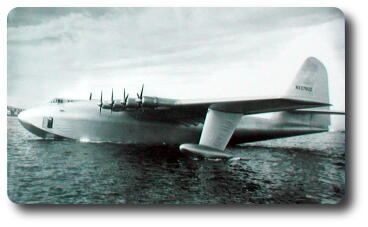Spruce Goose History
Click on an image to see a larger version
World's Largest Aircraft
 As the largest airplane ever constructed, and flown only one
time on November 2, 1947, the Hughes
Flying Boat
represents one of man's greatest attempts to conquer the skies.
The single hull prototype was built as a personnel and materiel
carrier. The aircraft was designed to fly trans-Atlantic to
avoid the World War II German submarines that were sinking Allied ships.
As the largest airplane ever constructed, and flown only one
time on November 2, 1947, the Hughes
Flying Boat
represents one of man's greatest attempts to conquer the skies.
The single hull prototype was built as a personnel and materiel
carrier. The aircraft was designed to fly trans-Atlantic to
avoid the World War II German submarines that were sinking Allied ships.
To produce the giant, Howard Hughes and his staff worked from
1942 to 1947, spending $US18,000,000 federal dollars and
$US7,000,000 of Hughes' own money. Henry Kaiser, steel magnate
and "Liberty" ship builder, conceived the idea of massive flying
transports, and turned to Howard Hughes for aviation expertise.
Hughes took on the mammoth task, along with the government mandate
not to use material critical to the war effort (such as steel
and aluminium). Nearly six times bigger than any aircraft of
its time, the
Flying Boat
is made out of wood!
Completed in 1947 after the end of World War II, the winged
giant made only one flight. The unannounced decision to fly
was made by the pilot, Hughes himself, during a taxi test.
The flight went only a little over a mile (1.5 km) at an
altitude of 70 feet (20 m) for about one minute. But, the short
hop proved to skeptics that the gigantic machine could, indeed, fly!
The Names
Originally designated HK-1 for the first aircraft built by
Hughes-Kaiser, the giant was re-designated H-4 for Hughes'
fourth aircraft, when Henry Kaiser withdrew from the project in 1944.
Other names include "Hercules", which was awarded after a company
contest, and the "Flying Lumberyard", a somewhat derogatory term.
A 1946 issue of
Flying Magazine
settled on the less derogatory "Wooden Wonder".
 The press insisted on calling the Hughes
Flying Boat
the "Spruce Goose", a name that Howard Hughes despised. The
funny thing about the nickname is that most of the plane is
actually made of birch, with only small amounts of maple, poplar,
balsa and, yes, spruce. Birch was chosen because testing proved
it to be light, strong and resistant to splitting, dry rot and deterioration.
The press insisted on calling the Hughes
Flying Boat
the "Spruce Goose", a name that Howard Hughes despised. The
funny thing about the nickname is that most of the plane is
actually made of birch, with only small amounts of maple, poplar,
balsa and, yes, spruce. Birch was chosen because testing proved
it to be light, strong and resistant to splitting, dry rot and deterioration.
| Specifications |
| Type: |
Cargo Aircraft Prototype |
| First Flight: |
November 2, 1947 |
| Wingspan: |
319 feet, 11 inches |
| Length: |
218 feet, 8 inches |
| Height: |
79 feet, 4 inches |
| Tail Span: |
113 feet, 6 inches |
| Wing Area: |
11,430 square feet |
| Weight, Empty: |
300,000 pounds |
| Weight, Loaded: |
400,000 pounds (maximum take-off weight) |
| Power: |
Eight Pratt & Whitney R-4360 3,000 horsepower engines |
| Propellors: |
Eight, with diameter of 17 feet, 2 inches |
| Payload: |
130,000 pounds |
| Normal Crew: |
18 |
| Capacity: |
750 troops or two Sherman tanks |
| Typical Armament: |
None |
| Performance |
| Cruise Speed: |
141 - 150 miles per hour at 5,000 feet |
| Top Speed: |
227 - 231 miles per hour at 5,000 feet |
| Range: |
2,975 miles with 12,500 gallons of fuel |
| Service Ceiling: |
17,400 to 20,900 feet |
Updated at 20:48 EST on Thu Nov 9, 2006
 The press insisted on calling the Hughes
Flying Boat
the "Spruce Goose", a name that Howard Hughes despised. The
funny thing about the nickname is that most of the plane is
actually made of birch, with only small amounts of maple, poplar,
balsa and, yes, spruce. Birch was chosen because testing proved
it to be light, strong and resistant to splitting, dry rot and deterioration.
The press insisted on calling the Hughes
Flying Boat
the "Spruce Goose", a name that Howard Hughes despised. The
funny thing about the nickname is that most of the plane is
actually made of birch, with only small amounts of maple, poplar,
balsa and, yes, spruce. Birch was chosen because testing proved
it to be light, strong and resistant to splitting, dry rot and deterioration.
 As the largest airplane ever constructed, and flown only one
time on November 2, 1947, the Hughes
Flying Boat
represents one of man's greatest attempts to conquer the skies.
The single hull prototype was built as a personnel and materiel
carrier. The aircraft was designed to fly trans-Atlantic to
avoid the World War II German submarines that were sinking Allied ships.
As the largest airplane ever constructed, and flown only one
time on November 2, 1947, the Hughes
Flying Boat
represents one of man's greatest attempts to conquer the skies.
The single hull prototype was built as a personnel and materiel
carrier. The aircraft was designed to fly trans-Atlantic to
avoid the World War II German submarines that were sinking Allied ships.